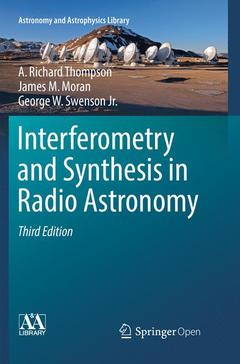Interferometry and Synthesis in Radio Astronomy (3rd Ed., 3rd ed. 2017) Astronomy and Astrophysics Library Series
Auteurs : Thompson A. Richard, Moran James M., Swenson Jr. George W.

This book is open access under a CC BY-NC 4.0 license.
The third edition of this indispensable book in radio interferometry provides extensive updates to the second edition, including results and technical advances from the past decade; discussion of arrays that now span the full range of the radio part of the electromagnetic spectrum observable from the ground, 10 MHz to 1 THz; an analysis of factors that affect array speed; and an expanded discussion of digital signal-processing techniques and of scintillation phenomena and the effects of atmospheric water vapor on image distortion, among many other topics.
With its comprehensiveness and detailed exposition of all aspects of the theory and practice of radio interferometry and synthesis imaging, this book has established itself as a standard reference in the field. It begins with an overview of the basic principles of radio astronomy, a short history of the development of radio interferometry, and an elementary discussion of the operation of an interferometer. From this foundation, it delves into the underlying relationships of interferometry, sets forth the coordinate systems and parameters to describe synthesis imaging, and examines configurations of antennas for multielement synthesis arrays. Various aspects of the design and response of receiving systems are discussed, as well as the special requirements of very-long-baseline interferometry (VLBI), image reconstruction, and recent developments in image enhancement techniques and astrometric observations. Also discussed are propagation effects in the media between the source and the observer, and radio interference, factors that limit performance. Related techniques are introduced, including intensity interferometry, optical interferometry, lunar occultations, tracking of satellites in Earth orbit, interferometry for remote Earth sensing, and holographic measurements of antenna surfaces.
This book will benefit anyone who is interested in radio interferometry techniques for astronomy, astrometry, geodesy, or electrical engineering.
A. Richard Thompson received his PhD in physics in 1956 from the University of Manchester, England. As a graduate student at the Jodrell Bank Experimental Station, he developed a radio interferometer for measurement of angular widths of radio sources. In 1956–1957 he worked with EMI Electronics, in the United Kingdom, on missile guidance and telemetry. He then joined the staff of Harvard College Observatory as a research associate in 1961–1962, working on solar studies at the Harvard Radio Astronomy Station, Fort Davis, Texas. In 1962 he joined the electrical engineering department of Stanford University as a radio astronomer, and as a senior research associate in 1970–1972. In 1973 he joined the National Radio Astronomy Observatory (NRAO) and with the Very Large Array (VLA) project, served as systems engineer, head of electronics, and deputy project manager. During 1984–1992 he worked on the Very Long Baseline Array project as systems engineer and deputy manager. Beginning in 1992 he was assistant head of the NRAO Central Development Lab and retired in 1999. He is currently an emeritus scientist at NRAO. Thompson was also active in frequency coordination for radio astronomy, and in 1978–1998 he was a member of US Study Group 7 of the International Telecommunication Union. He was a member of the Committee on Radio Frequencies of the National Academy of Sciences in 1980–1991. During 1982–1988 he was secretary of the Interunion Commission for Allocation of Frequencies for Radio Astronomy and Space Sciences. He is a member of the International Union of Radio Science, Commission 40 of the International Astrophysical Union, and the American Astronomical Society (AAS). He is a Fellow of the Institute of Electrical and Electronic Engineers (IEEE).
James M. Moran received his PhD in electrical engineering from the Massachusetts Institute of Technology in 1968, where his thesis involved the development of spectral line capability for very-long-baselin
Explores all aspects of radio interferometry in depth with full, relevant mathematical derivations
Provides extensive updates to the second edition, including results and technical advances from the past decade; discussion of arrays that now span the full range of the radio part of the electromagnetic spectrum observable from the ground, 10 MHz to 1 THz; an analysis of factors that affect array speed
Presents thorough explanations of how the atmosphere and other sources of phase noise limit the astrometric accuracy and dynamic range of images
Discusses the substantial progress made in recent years in the area of very wide field image formation, as a result of the creation of the Murchison Widefield Array (MWA) in Australia, the Low Frequency Array (LOFAR) in Europe, and the Long Wavelength Array (LWA) in the US
Date de parution : 07-2018
Ouvrage de 872 p.
15.5x23.5 cm
Date de parution : 03-2017
Ouvrage de 872 p.
15.5x23.5 cm
Mots-clés :
Digital signal processing; Interferometry textbook; Radio astronomy textbook; Radio frequency interference; Radio interferometry; Radio interferometry textbook; Radio propagation effects; Synthesis array; Synthesis mapping; Thompson interferometry; Very-long-baseline interferometry (VLBI)



